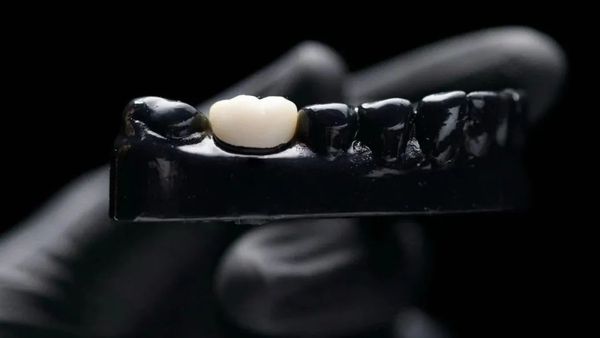The light-curing crown and bridge resin for additive manufacturing has been approved as a Class III medical device by the NMPA (National Medical Products Administration).
Recently, the "photopolymer crown-bridge resin for additive manufacturing" independently developed by Quanshi Technology has officially obtained registration as a Class III medical device from the National Medical Products Administration (NMPA)! This milestone breakthrough signifies that Quanshi Technology's capabilities and technological reliability in the digital dentistry field have once again received national-level recognition, and injects strong momentum into the innovative application of dental restoration materials in China.

The light-curing crown and bridge resin certified this time is specially designed for the field of oral restoration. It is a new type of dental restoration material mainly used for the repair of tooth defects. The material characteristics are as follows:
-
Elasticity and toughness: Compared to traditional composite resin or ceramic materials, 3D printed resin ceramic inlays possess greater flexibility and impact resistance, better distributing bite forces and reducing the risk of restoration fracture.
-
Biocompatibility: The material is non-toxic, has low irritation to the dental pulp and gums, and is suitable for sensitive patients.
-
Aesthetics: The color is close to natural teeth, suitable for repairs in the anterior teeth or visible areas.
-
For medium to small-sized defects in posterior teeth, especially in molars that承受较大咬合力, this restoration is particularly suitable. (注:最后一部分“尤其适用于承受较大咬合力的”在翻译时需要更好地融入句子以保持语句通顺,因此翻译为"especially in molars that"。如果需要更准确地翻译,可以改为 "especially for molars that bear substantial occlusal forces"。) -
The interdental seal can cushion and absorb shock, preventing the crack from propagating further. -
For patients with occlusal sensitivity: elastic materials can reduce occlusal discomfort. -
Minimal Invasive Treatment: Requires only slight tooth reduction, preserving more healthy dental tissue.
G冠桥树脂 is typically used for fabricating permanent restorations such as crowns, bridges, inlays, onlays, and veneers. The cost of制作的成本 needs to have strong mechanical properties to meet the demands of chewing function, while also needing to have biocompatibility. Depending on the characteristics of the resin purchased, it can be used for short-term, long-term, or permanent use. Additionally, according to the current condition of the patient's existing teeth, different colors need to be selected. Note: "G冠桥树脂" seems to be incorrectly formatted. If you meant to use a specific term or brand name, please provide the correct term. The rest of the content has been translated assuming "冠桥树脂" refers to "dental resin" or a similar material used in dental restorations.
The main components of light-curing crown and bridge resin include:
-
Urethane dimethacrylate: This is an important component that provides strength and durability to the resin. -
Bisphenol A glycidyl methacrylate: This component contributes to the stability and chemical resistance of the resin. -
(Glycidyl methacrylate): It enhances the flow and plasticity of the resin. -
Camphor quinone: a photosensitizer used to promote the curing reaction of resins. -
For N,N'-dimethylbenzylamide: This component helps regulate the curing speed and reactivity of resins. -
Silica, barium glass powder, and iron oxide: these components provide the resin with physical strength and color stability.
The process of preparing polypropylene crown resin involves the following steps: 1. Mixing the resin and initiator 2. Purging the mixture 3. Curing the mixture 4. Annealing (heat treatment) 5. Finishing 6. Fitting to dental appliances
Light-cured crown and bridge resin solidifies through the addition of a photoinitiator to the composite resin and subsequent exposure to a light source. This resin is also known as photosensitive composite resin, which forms a solid material with a fixed shape through a polymerization reaction. Its applications include:
-
Temporary Restoration Fabrication: Used for making temporary restorations and providing retention for temporary dentures, suitable for situations requiring short-term restoration. -
3D printing materials: Used for the production of temporary crowns and bridges, featuring excellent mechanical properties and color stability, suitable for long-term use in the oral cavity.
【Copyright and Disclaimer】The above information is collected and organized by PlastMatch. The copyright belongs to the original author. This article is reprinted for the purpose of providing more information, and it does not imply that PlastMatch endorses the views expressed in the article or guarantees its accuracy. If there are any errors in the source attribution or if your legitimate rights have been infringed, please contact us, and we will promptly correct or remove the content. If other media, websites, or individuals use the aforementioned content, they must clearly indicate the original source and origin of the work and assume legal responsibility on their own.
Most Popular
-

List Released! Mexico Announces 50% Tariff On 1,371 China Product Categories
-

Nissan Cuts Production of New Leaf EV in Half Due to Battery Shortage
-

New Breakthrough in Domestic Adiponitrile! Observing the Rise of China's Nylon Industry Chain from Tianchen Qixiang's Production
-

Dow, Wanhua, Huntsman Intensively Raise Prices! Who Controls the Global MDI Prices?
-

Mexico officially imposes tariffs on 1,400 chinese products, with rates up to 50%






